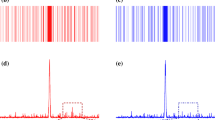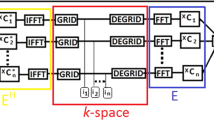Abstract
In compressed sensing magnetic resonance imaging (CS-MRI), undersampling of k-space is performed to achieve faster imaging. For this process, it is important to acquire data randomly, and an optimal random undersampling pattern is required. However, random undersampling is difficult in two-dimensional (2D) Cartesian sampling. In this study, the effect of random undersampling patterns on image reconstruction was clarified using phantom and in vivo MRI, and a sampling pattern relevant for 2D Cartesian sampling in CS-MRI is suggested. The precision of image restoration was estimated with various acceleration factors and extents for the fully sampled central region of k-space. The root-mean-square error, structural similarity index, and modulation transfer function were measured, and visual assessments were also performed. The undersampling pattern was shown to influence the precision of image restoration, and an optimal undersampling pattern should be used to improve image quality; therefore, we suggest that the ideal undersampling pattern in CS-MRI for 2D Cartesian sampling is one with a high extent for the fully sampled central region of k-space.








Similar content being viewed by others
References
Mann LW, Higgins DM, Peters CN, Cassidy S, Hodson KK, Coombs A, Taylor R, Hollingsworth KG. Accelerating MR imaging liver steatosis measurement using combined compressed sensing and parallel imaging: a quantitative evaluation. Radiology. 2016;278(1):247–56.
Li B, Li H, Kong H, Dong L, Zhang J, Fang J. Compressed sensing based simultaneous black- and gray-blood carotid vessel wall MR imaging. Magn Reson Imaging. 2017;38:214–23.
Kido T, Kido T, Nakamura M, Watanabe K, Schmidt M, Forman C, Mochizuki T. Compressed sensing real-time cine cardiovascular magnetic resonance: accurate assessment of left ventricular function in a single-breath-hold. J Cardiovasc Magn Reson. 2016;18(1):50.
Han S, Cho H. Temporal resolution improvement of calibration-free dynamic contrast-enhanced MRI with compressed sensing optimized turbo spin echo: the effects of replacing turbo factor with compressed sensing accelerations. J Magn Reson Imaging. 2016;44(1):138–47.
Kim SG, Feng L, Grimm R, Freed M, Block KT, Sodickson DK, Moy L, Otazo R. Influence of temporal regularization and radial undersampling factor on compressed sensing reconstruction in dynamic contrast enhanced MRI of the breast. J Magn Reson Imaging. 2016;43(1):261–9.
Nam S, Hong SN, Akçakaya M, Kwak Y, Goddu B, Kissinger KV, Manning WJ, Tarokh V, Nezafat R. Compressed sensing reconstruction for undersampled breath-hold radial cine imaging with auxiliary free-breathing data. J Magn Reson Imaging. 2014;39(1):179–88.
Rapacchi S, Han F, Natsuaki Y, Kroeker R, Plotnik A, Lehrman E, Sayre J, Laub G, Finn JP, Hu P. High spatial and temporal resolution dynamic contrast-enhanced magnetic resonance angiography using compressed sensing with magnitude image subtraction. Magn Reson Med. 2014;71(5):1771–83.
Wang H, Miao Y, Zhou K, Yu Y, Bao S, He Q, Dai Y, Xuan SY, Tarabishy B, Ye Y, Hu J. Feasibility of high temporal resolution breast DCE-MRI using compressed sensing theory. Med Phys. 2010;37(9):4971–81.
Smith DS, Welch EB, Li X, Arlinghaus LR, Loveless ME, Koyama T, Gore JC, Yankeelov TE. Quantitative effects of using compressed sensing in dynamic contrast enhanced MRI. Phys Med Biol. 2011;56(15):4933–46.
Worters PW, Sung K, Stevens KJ, Koch KM, Hargreaves BA. Compressed-sensing multispectral imaging of the postoperative spine. J Magn Reson Imaging. 2013;37(1):243–8.
Zhang T, Chowdhury S, Lustig M, Barth RA, Alley MT, Grafendorfer T, Calderon PD, Robb FJ, Pauly JM, Vasanawala SS. Clinical performance of contrast enhanced abdominal pediatric MRI with fast combined parallel imaging compressed sensing reconstruction. J Magn Reson Imaging. 2014;40(1):13–25.
Lustig M, Donoho D, Pauly JM. Sparse MRI. The application of compressed sensing for rapid MR imaging. Magn Reson Med. 2007;58(6):1182–95.
Haldar JP, Hernando D, Liang ZP. Compressed-sensing MRI with random encoding. IEEE Trans Med Imaging. 2011;30(4):893–903.
Pandey A, Yoruk U, Keerthivasan M, Galons JP, Sharma P, Johnson K, Martin DR, Altbach MI, Bilgin A, Saranathan M. Multiresolution imaging using golden angle stack-of-stars and compressed sensing for dynamic MR urography. J Magn Reson Imaging. 2017;46(1):303–11.
Sharma SD, Fong CL, Tzung BS, Law M, Nayak KS. Clinical image quality assessment of accelerated magnetic resonance neuroimaging using compressed sensing. Invest Radiol. 2013;48(9):638–45.
Kawata S, Nalcopglu O. Constrained iterative reconstruction by the conjugate gradient method. IEEE Trans Med Imaging MI. 1985;-4(2):65–71.
Zeng GL. Medical image reconstruction. a conceptual tutorial. New York: Springer; 2010. pp. 131–134 (146–147).
Wang Z, Bovik AC, Sheikh HR, Simoncelli EP. Image quality assessment: from error visibility to structural similarity. IEEE Trans Image Process. 2004;13(4):600–12.
Akasaka T, Fujimoto K, Yamamoto T, Okada T, Fushumi Y, Yamamoto A, Tanaka T, Togashi K. Optimization of regularization parameters in compressed sensing of magnetic resonance angiography: can statistical image metrics mimic radiologists’ perception? PLoS One. 2016;11(1).
Steckner MC, Drost DJ, Prato FS. Computing the modulation transfer function of a magnetic resonance imager. Med Phys. 1994;21(3):483–9.
Acknowledgements
We thank Karl Embleton, Ph.D., from Edanz Group (http://www.edanzediting.com/ac) for editing a draft of this manuscript.
Author information
Authors and Affiliations
Corresponding author
Ethics declarations
Ethical approval
All procedures involving human participants were in accordance with the ethical standards of the Institutional Review Board (IRB) and with the 1964 Helsinki declaration and its later amendments or comparable ethical standards. The IRB waived the requirement for patients’ informed consent. This study does not involve any experiments involving animals.
Informed consent
The requirement for informed consent was waived by the institutional review board because of the retrospective nature of the analysis.
Conflict of interest
The authors declare that they have no conflict of interest in this article.
About this article
Cite this article
Kojima, S., Shinohara, H., Hashimoto, T. et al. Undersampling patterns in k-space for compressed sensing MRI using two-dimensional Cartesian sampling. Radiol Phys Technol 11, 303–319 (2018). https://doi.org/10.1007/s12194-018-0469-y
Received:
Revised:
Accepted:
Published:
Issue Date:
DOI: https://doi.org/10.1007/s12194-018-0469-y




